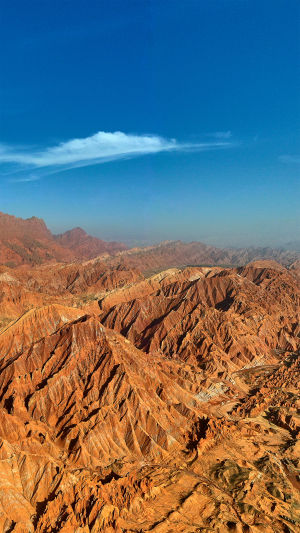The world's geological wonders stand as remarkable testaments to the awe-inspiring craftsmanship of nature.
From Egypt's iconic pyramids to Australia's breathtaking Great Barrier Reef, these landscapes not only leave us in profound wonder of the Earth's intricate history but also offer invaluable insights for global geological research.
With their wealth of geological data and unique natural beauty, geological wonders like Yellowstone Park in the United States are indispensable facets of our cultural and natural heritage.
Hidden within the Wolf Hills, nestled on the border of Utah and Arizona in the United States, lies a natural sandstone sculpture known as the Stone Wave. This captivating work of art, spanning less than 200 square meters of mountain crevices, features blood-red sandstone resembling crashing waves—an exquisite blend of solidity and softness that commands breathtaking admiration.
The Wolf Hills are part of the Paria Valley, stretching across the states of Utah and Arizona, and fall under the jurisdiction of the U.S. Bureau of Land Management. The Paria Valley offers three distinct areas open for exploration: South Wolf Hills, North Wolf Hills, and the Paria Valley Riverwalk. The Stone Wave graces the end of North Wolf Hills.
It's worth noting that these areas are not national parks; due to their delicate ecosystems, they are heavily protected. To preserve these remarkable natural wonders, a strict limit of only 20 permits is issued daily for each area, with an equal distribution of 10 permits available on-site and 10 permits obtainable through online reservation. This careful allocation system guarantees the continued preservation of these extraordinary places, safeguarding their pristine beauty for generations to come.
Located in the northern region of Arizona, Antelope Canyon stands as one of the world's most renowned slot canyons and a celebrated photographic attraction.
Antelope Canyon is topographically divided into two distinctive sections—Upper and Lower Antelope Canyons, often known as the "Rift" and the "Spiral," respectively. The interplay of natural light, refracted through the varying depths of the red rock crevices, bathes the canyon in ever-changing hues.
The enchanting light display shifts not just seasonal but throughout the day, providing visitors with a stunning, ever-evolving visual experience akin to entering a captivating and colorful otherworldly realm.
Venturing the Sichuan Ink Stone Canyon in western China introduces us to a different geological marvel. The canyon boasts a unique and astonishing geological structure, showcasing an array of landforms and peculiar rock formations created by natural forces like earthquakes and crustal movements.
As a result, Chuanxi Murashi Canyon has become a favored destination for explorers and geologists alike.
Whether exploring the geological wonders, seeking out Earth's unspoiled paradises, or delving into the Chuanxi Murashi Canyon, these locations all hold vital roles in our understanding of our planet. Their significance goes beyond their awe-inspiring natural beauty; they serve as critical references for global geological and ecological research.
These world-class natural wonders are a treasure trove of knowledge for human civilization, providing profound insights into Earth's history and the laws of nature. Their existence reminds us to revere nature's power and to cherish and protect the Earth, our home.
Nonetheless, it is crucial to acknowledge that impacts are irreversible once these sites are damaged or stripped of their protection. As Earth's stewards, we carry the responsibility and duty of safeguarding these precious natural heritages.
Let us unite in our efforts to ensure that these splendid landscapes continue to shine for eternity, offering our future generations a beautiful and sustainable home.





